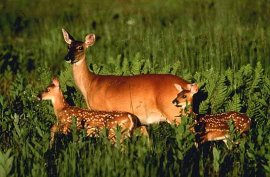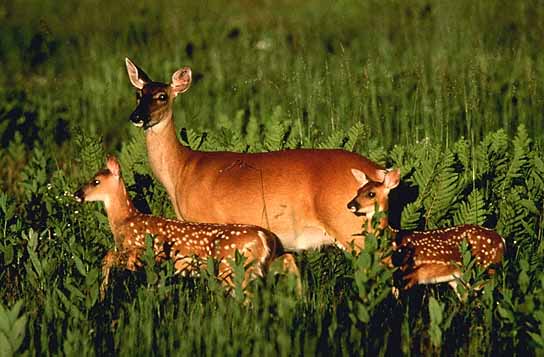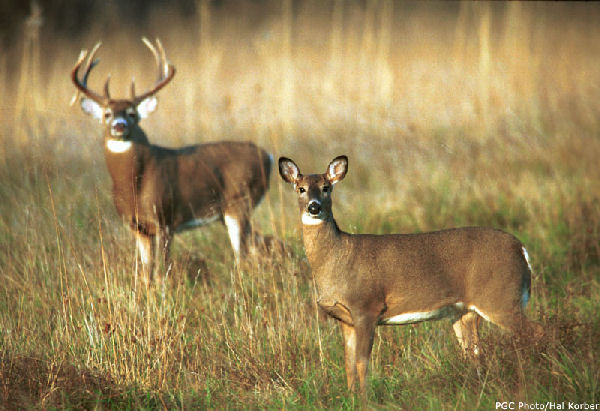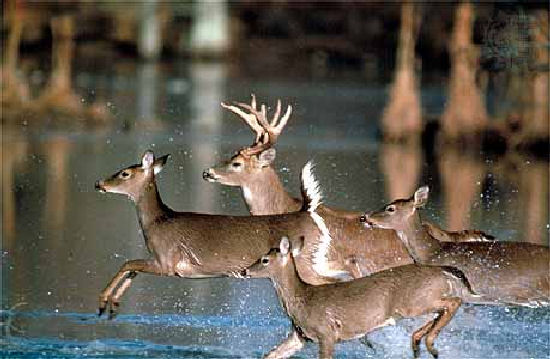Hoofed Mammals
Endangered Status
Two subspecies of the White-tailed Deer are on the U.S. Endangered Species List. The Key Deer is classified as endangered in Florida, and the Columbian White-tailed Deer is classified as endangered in Washington and Oregon. The Key Deer declined in number as more and more of its habitat in the Florida Keys underwent development throughout the 20th century. Development continues to be a threat to the subspecies today. In 1961 the National Key Deer Refuge was established to protect the deer. The population has risen from a possible low of 25 animals in 1955 to about 250 to 300 today. The Columbian White-tailed Deer once ranged from Puget Sound to southern Oregon, where it lived in floodplain and riverside habitat. The conversion of much of its homeland to agriculture and unrestricted hunting reduced its numbers to a just a few hundred in the early 20th century. It now lives in a few scattered populations, and its numbers have climbed to over 6,000. Julia Butler Hansen Refuge for the Columbian Whitetail Deer provides critical habitat for these deer in southern Washington.
![]()
Warning
The White-tailed Deer population has become a public-health concern with the onset of Lyme disease, which is transmitted by ticks carried by the deer. These ticks are tiny and their nymphs are almost microscopic; both nymphs, active May through July, and adults, active on warm days from August through May, can be infectious. They inhabit woods and fields, especially where deer are numerous, and occur on both deer and mice. Lyme disease is a dangerous bacterial illness. Initial symptoms vary, but about 75 to 80 percent of all victims develop a circular, expanding, bulls-eye-shaped red rash around the tick bite, up to 35 days after the bite. Other symptoms include stiff neck, headache, dizziness, fever, sore throat, muscle aches, joint pain, and general weakness. Antibiotics are most effective in early stages of infection. Untreated Lyme disease can be difficult to cure, and may cause chronic arthritis, memory loss, and severe headaches.
Sign
Raggedly browsed vegetation, ripped rather
than neatly snipped due to lack of upper incisors.
"Buck rubs":
Polished scars or oblong sections where bark has been removed from
bushes, saplings, or small trees, usually close to the ground; made
when a buck lowers his head and rubs antlers against a tree to mark
territory; trees chosen to fit antlers (e.g., a rub on a tree with a
diameter of 4–5"/100–125 mm would have been made by a very large
buck).
"Buck scrapes": Pawed depressions with broken branches
about 3–6' (1–2 m) above the ground.
Bed: Shallow, oval,
body-size depression in leaves or snow.
Scat: When browsing,
almost always hard, dark, cylindrical pellets, about 3/4" (19 mm)
long; sometimes round. When grazing on succulent vegetation,
cylindrical and segmented, evenly massed.
Tracks: Like narrow
split hearts, pointed end forward, about 2–3" (50–75 mm) long;
dewclaws may print as twin dots behind main prints in snow or soft
mud. In shallow snow (1"/25 mm deep), buck may drag its feet,
leaving drag marks ahead of prints; in deeper snow, both buck and
doe drag feet. Straddle 5–6" (125–150 mm) wide. Stride, when
walking, 1' (.3 m); when running, 6' (2 m) or more, and hindprints
sometimes register ahead of foreprints; when leaping, 20' (6 m).
Well-used trails are very noticeable, with numerous prints and
damaged vegetation.
Discussion
Although primarily nocturnal, the White-tailed Deer may be active at any time. It often moves to feeding areas along established trails, then spreads out to feed. The animal usually beds down near dawn, seeking concealing cover. This species is a good swimmer. The winter coat of the northern deer has hollow hair shafts, which fill with air, making the coat so buoyant that it would be difficult for the animal to sink should it become exhausted while swimming. The White-tailed Deer is also a graceful runner, with top speeds to 36 mph (58 km/h), although it flees to nearby cover rather than run great distances. This deer can make vertical leaps of 8 1/2 feet (2.6 m) and horizontal leaps of 30 feet (9 m). The White-tailed Deer grazes on green plants, including aquatic ones in the summer; eats acorns, beechnuts, and other nuts and corn in the fall; and in winter browses on woody vegetation, including the twigs and buds of viburnum, birch, maple, and many conifers. The four-part stomach allows the deer to feed on items that most other mammals cannot eat. It can obtain nutrients directly from the food, as well as nutrients synthesized by microbes in its digestive system. This deer eats 5 to 9 pounds (2.25–4 kg) of food per day and drinks water from rain, snow, dew, or a water source. When nervous, the White-tailed Deer snorts through its nose and stamps its hooves, a telegraphic signal that alerts other nearby deer to danger. If alarmed, the deer raises, or "flags," its tail, exhibiting a large, bright flash of white; this communicates danger to other deer and helps a fawn follow its mother in flight.There are two types of social grouping: the family group of a doe and her young, which remain together for nearly a year (and sometimes longer), and the buck group. The family group usually disbands just before the next birth, though occasionally two sets of offspring are present for short periods. Bucks are more social than does for most of the year, forming buck groups of three to five individuals; the buck group, which constantly changes and disbands shortly before the fall rut, is structured as a dominance hierarchy. Threat displays include stares, lowered ears, and head-up and head-down postures. Attacks involve kicking and, less commonly, rearing and flailing with the forefeet. Bucks and does herd separately most of the year, but in winter they may gather together, or "yard up." As many as 150 deer may herd in a yard. Yarding keeps the trails open through the movement of large groups of animals, and provides protection from predators. The leadership of the yards is matriarchal. Deer may occupy the same home range year after year, and may defend bedding sites, but otherwise are not territorial. The White-tailed Deer is less polygamous than other deer, and a few bucks mate with only one doe. The extended rutting season begins at about the time the male is losing his velvet, which varies with latitude. At this time, bucks are still in buck groups, and sparring for dominance increases. (Sparring consists of two deer trying to push each other backward.) The buck group then breaks up, and several bucks begin following a doe at a distance of 150 feet (50 m) or so. They follow the doe’s scent; the largest buck stays closest to the female. A buck attempts to dominate other bucks and may mate with several does over the breeding season. He produces "buck rubs" and also "scrapes," revisiting them regularly during the rut; glandular secretions are left on the rubs. Does visit the scrapes and urinate in them; bucks then follow the trails of the does. After the mating season, the doe returns to the subherd until spring (May or June in the North; January to March in the deep South). A young doe bred for the first time usually produces one fawn, but thereafter has twins and occasionally triplets if food is abundant. The female remains near the fawns, returning to feed them only once or twice a day. Twin fawns are separated, which serves to protect them. Weaning occurs between one and two and a half months. Fawns stay with the mother into the fall or winter, sometimes for up to two years, but the doe generally drives off her young of the previous year shortly before giving birth. The Whitetail’s first antlers are usually a single spike (the "spikehorn"). A three-year-old would be expected to have eight points, but there can be more or less, as the number of tines is influenced greatly by nutritional factors. A Whitetail’s age is determined not by the number of tines on its horns but by the wear on its teeth.
Once nearly exterminated in much of the Northeast and Midwest, this deer is now more abundant than ever, owing to hunting restrictions and the decline in number of its predators, wolves and the Mountain Lion. It has become the most plentiful game animal in eastern North America and is even something of a pest in many areas, eating garden plants and contributing to the spread of Lyme disease. Thinning the deer population is best done by hunting both does and bucks, as hunting bucks only alters the herd rather than reducing it. There are two dwarf subspecies of White-tailed Deer: the Coues’ Deer, or Arizona Whitetail (O. v. couesi), of the Arizona desert, and the Key Deer (O. v. clavium) of the Big Pine Key area in the Florida Keys. The Coues’ Deer, which has somewhat enlarged ears and tail relative to the other Whitetails, reaches a maximum of about 100 pounds (45 kg). The tiny, dog-size Key Deer weighs 50 pounds (23 kg) or less. Some mammalogists classify the Key Deer as a separate species.








